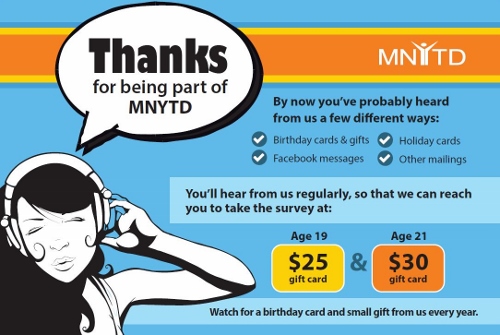Young people in foster care often face extraordinary struggles as they transition to independent living. Without access to essential support systems, youth leaving the foster care system become more prone to homelessness, unemployment, incarceration, and physical or mental illness. Young people are also difficult to track after they leave the foster care system, making it challenging to follow their stories or understand their unique needs as they transition into adulthood.
Almost a decade ago, the federal government created the National Youth in Transition Database (NYTD) to fill the significant gap in information about youth who have experienced out-of-home placement (including foster care, corrections, mental health and treatment placements). Here in Minnesota, the Department of Human Services (DHS) and The Improve Group have been leading the statewide effort to track and monitor foster youth as they move toward independent living.
In 2010, DHS launched the Minnesota Youth in Transition Database (MNYTD) to gather federally mandated, baseline data about youth receiving independent living services through the state. The agency conducted an initial survey, asking all 17-year olds in out-of-home placement around the time of their birthday to assess their current status in several key areas of life, including financial self-sufficiency, experience with homelessness, educational attainment, positive connections with adults, high-risk behavior, and access to health insurance. Then DHS turned to The Improve Group to develop a strategy for following these same young adults over the next five years—and repeating the survey at ages 19 and 21 years—to trace their experiences through the significant transition to adulthood.
Our first priority was to build strong relationships with survey participants across the state—to establish trust and encourage them to stay in touch. Following DHS’s initial survey, we immediately began reaching out to all those who responded. We developed and rolled out an innovative, branded campaign—including a website devoted to the project—to engage and communicate with survey participants:
- After youth responded to their 17-year survey, we sent a welcome card to thank them for participating and to ask them to continue to update their contact information.
- Over the next year, we stayed in close touch with survey participants, sending birthday and holiday cards and including $5 gift cards as an incentive to stay engaged. We also reached out using social media channels like Facebook and Instagram, and used creative, eye-catching graphics and drawings in all our materials.
- If we lost touch with a respondent, we worked closely with case managers and family members to track down new contact information and reconnect with them.
- As youth reached their 19th birthdays, we shared the next survey with them through a mailing and via Facebook messages, and provided a $25 gift card for those who participated.
- Over the following two years, we continued to build trust with survey participants, sending cards and updates and finding new ways to spur their interest in the project. Young adults who responded to the third survey around their 21st birthday received a $30 gift card for sharing their insights and experiences.

All our materials and updates conveyed the same overarching message: by taking part in the survey, youth who have experienced out-of-home placement have a crucial opportunity to tell their story and make their voices heard. We collected data from youth in a range of situations—from those who remained in foster care after turning 18 to those who left the system completely—in order to understand the array of challenges facing this diverse population.
Through our ongoing outreach campaign, we have staying in close touch with youth across the state and encouraged many to respond to the MNYTD survey. Our response rates have reached close to 80 percent—an exceptionally high number in a population that is difficult to track. As a result, we have been able to help DHS reveal some key insights about youth in the midst of transitioning to adulthood. For example, we know today that youth who stay in extended foster care tend to experience better outcomes than those who transition out of the system earlier. These insights are helping officials at both the state and local level to understand the realities facing youth in foster care—and how we can work together to meet their needs.
